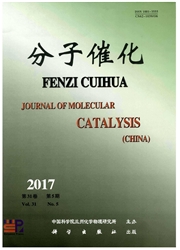

 中文摘要:
中文摘要:
文章采用微波加热,草酸盐共沉淀法制备了Ni3V2O8催化剂,并对催化剂进行了BET,XRD,H2-TPR,XPS,TEM和电导等技术表征,分析研究了Ni3V2O8催化剂的丙烷氧化脱氢(ODH)制丙烯催化性能与其表面物种的关系。XRD,TEM和电导实验结果表明本方法制得的Ni3V2O8催化剂晶粒均匀,平均粒径为30nm,具有p-型半导体性质。TPR和XPS实验结果显示Ni3V2O8催化剂中,晶格氧可以较容易转换成未完全还原氧,使催化剂内各种价态的钒之间易于进行氧化还原反应并形成氧缺位,从而催化剂的表面含有较多未充分还原氧物种O-和V4+物种。催化活性结果显示当丙烷的转化率为18.60%,丙烯选择性达到60.02%,在相同转化率条件下,比文献报道的NiO和Ni3V2O8共存催化体系中的丙烯选择性高,说明Ni3V2O8催化剂中存在未充分还原的O-和V4+物种有利于提高丙烯的选择性。
 英文摘要:
英文摘要:
Ni3 V2O8 catalyst was prepared by oxalate co-precipitation method with microwave heating in this paper. In order to study the relationship between the catalytic performance and the surface species, the catalyst was characterized by XRD, BET, H2-TPR, XPS, TEM and conductivity measurement. The surface property of Ni3V2O8 was studied by XPS and the catalytic performance of the oxidative dehydrogenation of propane to propylene was also investigated. The results of XRD showed that pure Ni3V2 O8 with nice structure was obtained. TEM experiments results demonstrated that the prepared Nh V2 O8 catalyst at 700 ℃ calcination showed uniform particle with the mean particle size of 30 nm. The surface area of the catalyst was 8. 623 m2·g^-1. The diagram of the relationship between electrical conductivity and oxygen partial pressure of Ni3V2O8 showed da/dPo2〉0, implying that Ni3 V2O8 catalyst was a p-type semiconductor. H2-TPR results showed that only one unsymmetrical reduction peak appeared at 663.5℃ within 300-900℃ region over Ni3 V2O8 catalyst and no obvious shoulder peak was observed. It could also be found that the ratio of non complete reduction oxygen species was about 33.59%(0- 27.55%, O2^2- 6.04%) from the O(1s) XPS result and more V^4+ species existed on the Ni3 V2O8 catalyst surface. The TPR and XPS results illustrated that the transformation of the lattice oxygen to non-complete reduction oxygen in Nh V2O8 catalyst might promote the oxidation-reduction reaction between different valence vanadium and promoted the oxygen vacancy formation. This then led to abundant non-complete reduction oxygen O- and V^4+ species formation on the surface of Ni3 V2O8 catalyst. The active result of oxidative dehydrogenation of propane to propylene showed that the 60.02% propylene selectivity could be reached at 18. 60% propane conversion. Compared with the reported results over the coexistent NiO and Ni3V2O8 system from the literature, pure Ni3V2O8 catalyst system in this present paper showed higher propylene sele
 同期刊论文项目
同期刊论文项目
 同项目期刊论文
同项目期刊论文
 期刊信息
期刊信息
